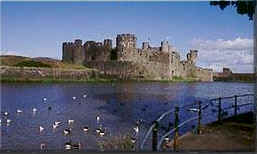 |
 |
 |
| Everything within a few miles, beaches | coal which built the Rhondda Valley | Norman castles like Caerphilly |
 |
 |
 |
| Everything within a few miles, beaches | coal which built the Rhondda Valley | Norman castles like Caerphilly |
Coal and iron mines came and went from the valleys of South Wales in less than 150 years. Not everywhere was ravaged by industry, the Gower and towns like Caerphilly and the Vale of Glamorgan were untouched by the development around them.
Even in the mining valleys themselves, life is changing. The unremitting rows of terraced houses, the pit heads, the smoking factory chimneys have been replaced by a brighter, cleaner, greener environment
 |
|
And to find out about places on the map of the Rhondda, check the gazetteer below
| Aberdare | Aberdare escaped much of the impact of coal mining, as the mining was carried out in side valleys off the Rhondda |
| . | |
| Barry | An odd mixture of places. The town boomed as a coal exporting port, and also as a holiday resort. Barry Island has, as well as a sandy beach, one of the largest amusement parks in Britain. Another pebble beach runs for two miles westwards. |
| . | |
| Bridgend | An old market town, with yet another Norman castle. Plus
a second Norman castle a mile away
Ewenny Priory, a mile to the south, was founded in 1141, but a sign of the times was that it was built with military defences which can still be seen |
| . | |
| Caerphilly | Noted for two things, Caerphilly castle and Caerphilly cheese. The castle is still there, the cheese is not. Manufacture of the white crumbly cheese has now moved away |
| . | |
| Cardiff
|
Seaport and current capital of Wales.
There was a Roman fort here, then a Norman castle in 1093. Cardiff Castle was substantially modified by the Marquis of Bute just over a century ago Also in Cardiff is Llandaff Cathedral, the National Rugby Stadium, the National Museum of Wales, the Welsh Folk Museum |
| . | |
| Neath | The Romans had a fort here, and the Normans a castle, and
the monks had built an abbey by 1130.
The Vale of Neath, stretching to the north east of the town is vary attractive, with waterfalls, gorges and wooded glens at the head of the vale. |
| . | |
| Porthcawl | A Welsh seaside resort, with sandy beaches and the inevitable large amusement park |
| . | |
| Rhondda | There were no roads here until 1850, then in the space of
a few years the Rhondda became one of the largest and best known coal
mining areas in Britain.
Now the coal mines have gone and the Rhondda is a cleaner place, but the great Welsh musical tradition remains - the brass bands and the choirs, like the Treorchy Male Voice Choir |
| . | |
| Swansea | The second city of Wales in population, a sea port and the
centre of processing of iron, steel, copper and other metals.
In spite of this Swansea has not spread uncontrollably, areas like the Gower on its doorstep are untouched by industrialisation. Oystermouth and the Mumbles are two seaside resorts actually inside Swansea's boundaries |
| . |
| Wales Regional Information Wales Regions |  |
|
| . | ||
| We have great hotels in Wales hotels in Wales |  |
Land of legends, coal and mountains - Rhondda, South Wales